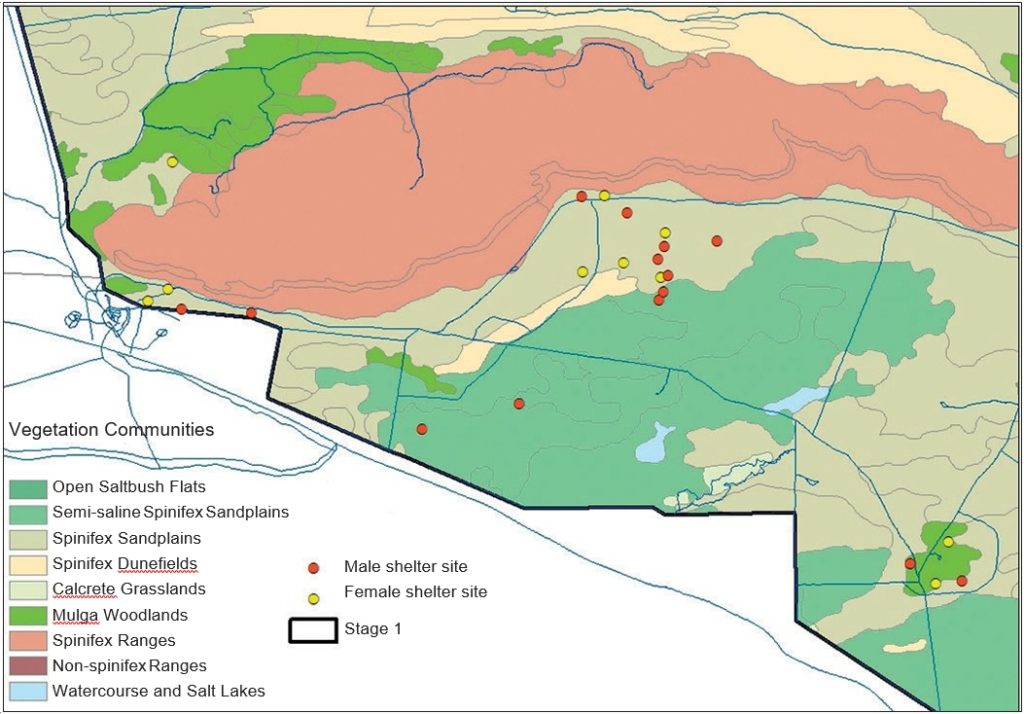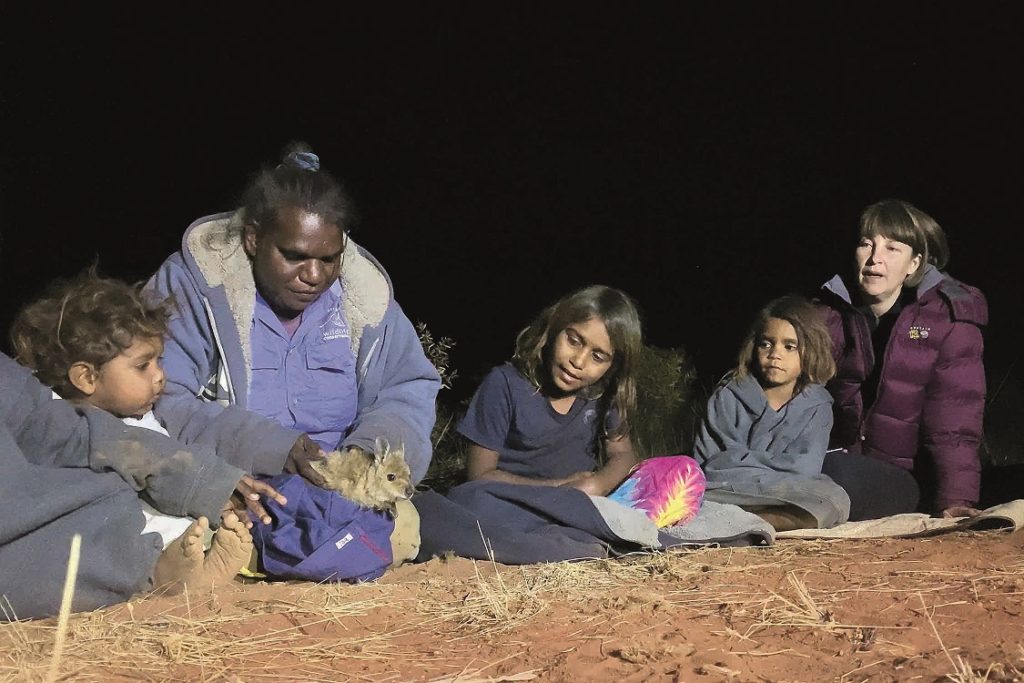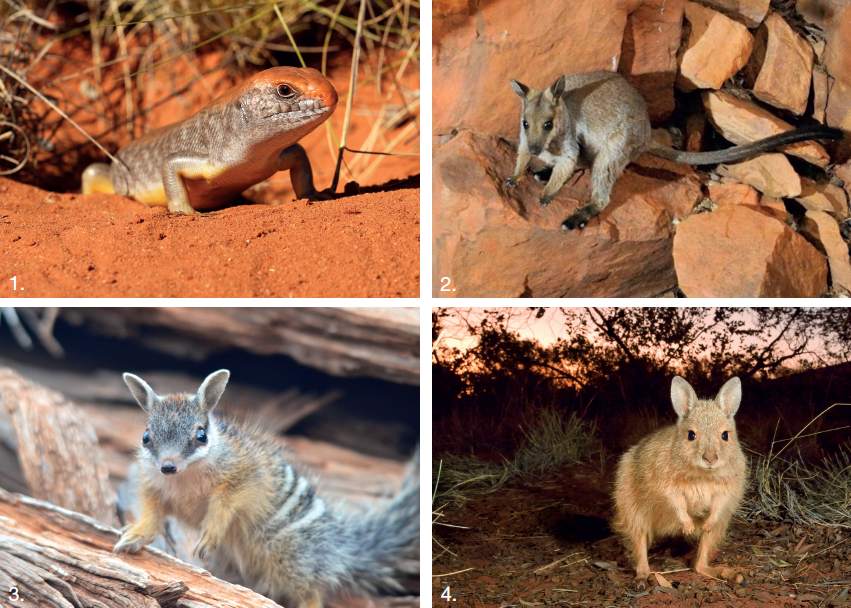By Dr Rachael Collett, Wildlife Ecologist, and James Stevens, Land Management Officer
At Newhaven Wildlife Sanctuary, AWC is undertaking a nationally significant reintroduction program, restoring at least 10 threatened native mammal species to central Australia.
In July 2019, the first reintroductions into Stage 1 were conducted, with the release of 30 Mala (Lagorchestes hirsutus) into the 9,400 hectare, feral predator-free area. Weighing just 800 to 1,600 grams, the Mala is a small, arid-adapted wallaby with long, soft, sandy-coloured fur. Although once widespread in the central and western deserts, predation by feral cats and foxes, and destructive wildfires, caused the last wild population on mainland Australia to go extinct in the early 1990s. Fortunately, a few Mala had been collected for a captive-breeding program, and it is the descendants of these animals, managed in insurance populations for several decades, that we are returning to establish the Newhaven population.

Included in the first release were the last remaining Mala from Watarrka National Park, which were moved to Newhaven in an emergency translocation in late 2017. The Watarrka population had been decimated after a massive wildfire left the animals exposed to birds of prey. AWC built a special purpose, 150 hectare, feral predator-free haven for the Mala while the larger, 9,400 hectare fenced area was completed. In 2018, we also translocated Mala from the insurance population at AWC’s Scotia Wildlife Sanctuary to the 150 hectare area at Newhaven. Cross-breeding between the Watarrka and Scotia Mala is expected to enhance the genetic diversity of the Newhaven population.
As well as being important for Mala conservation, this translocation provides an important opportunity to learn about the behaviour and habitat preferences of Mala in the central deserts. The Mala released into the 9,400 hectare feral predator-free area in July 2019 were fitted with radio-collars so AWC’s ecologists could continue to monitor their survival, behaviour and distribution.
 © Brad Leue/AWC
© Brad Leue/AWC
Since their release, radio-tracking has shown the Mala have successfully dispersed across much of the area around their release sites. As Mala prefer spinifex sandplain habitat, these animals have built burrows under large spinifex hummocks, sheltered by Acacia and Melaleuca shrubs. The burrows are tunnel-like structures with a spinifex roof. This provides a cool refuge during the heat of the day. In summer, they are likely to dig deeper burrows to withstand searing desert temperatures.
Ten of the released Mala were females and, as of the most recent survey in mid-September, five of the females were carrying pouch young. Additional Mala from Alice Springs Desert Park and from AWC’s Scotia Wildlife Sanctuary will be released into the feral predator-free area in 2019-20. We expect the population to eventually exceed 2,000 individuals. As a result of this reintroduction, Newhaven is now home to the only free-ranging population of Mala on mainland Australia.
AWC will commence reintroductions of Numbats (Myrmecobius fasciatus) and Red-tailed Phascogales (Phascogale calura) to Newhaven later in 2019-20. Both these species are extinct in the Northern Territory, and this project will enable their return to the central deserts.
Conservation management beyond the fence
Exciting as the reintroduction program is at Newhaven, it is important to remember that a number of threatened species still occur outside the fence, along with feral predators.
AWC has established a strategic feral animal control program outside the feral predator-proof fence to protect populations of threatened species, with a focus on the Great Desert Skink (Egernia kintorei)) and Black-footed Rock Wallaby (Petrogale lateralis). The Great Desert Skink is a large burrowing reptile that establishes complex communal burrow systems in semi-saline spinifex habitat on Newhaven.
Feral cats are a serious predator of the Great Desert Skink. Field observations have determined that individual cats systematically hunt skinks from burrow system to burrow system. AWC’s feral predator program aims to reduce the density of cats and disrupt hunting behaviour within and around key Great Desert Skink populations, with the aim of increasing the breeding success and population size of the species.

At the time of going to print, a total of 73 cats had been removed from Newhaven this year, with 55 of these taken near skink populations. The majority (54 cats) were trapped in ‘cat-a-vaults’, an enclosed box trap buried in the ground that provides a dark and cool environment. AWC has deployed 24 cat-a-vault traps across Newhaven to protect three populations of Great Desert Skinks and one population of Black-footed Rock Wallabies.
The exceptionally dry conditions throughout 2019 have resulted in cats moving great distances in search of prey, and in some cases, encountering the feral predator-proof fence on Newhaven. This has provided a unique opportunity to use the fence for a second purpose – not only keeping the cats out and providing a feral predator-free sanctuary for wildlife, but also in successfully funnelling travelling cats into waiting traps. For example, 51 cats were caught in June and July 2019, most near the southern boundary of the predator-free area.
As a national leader in threatened species translocations and in feral predator ecology, AWC plans to expand the feral-free area on Newhaven to 100,000 hectares. This will be the largest fenced, feral-free area on the planet, and will deliver huge conservation benefits, including the doubling in the population size of at least six threatened Australian mammal species.